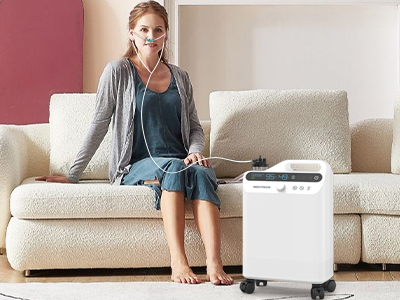23 Oct 2023
Oxygen concentrators have revolutionized healthcare by providing a steady and reliable supply of oxygen to those in need. They have become a lifeline for individuals with respiratory conditions, enhancing their quality of life and well-being.
How Oxygen Concentrators Work
To use oxygen concentrators safely, it's vital to understand their operation. These devices work by drawing in ambient air, removing impurities, and delivering purified oxygen. This process ensures that users receive the oxygen they need, but it also presents specific safety concerns.

Components and Mechanisms
Pulse dose oxygen concentrators, in contrast, deliver oxygen in sync with a patient's inhalation. This conserves oxygen and offers greater portability, suiting patients who need oxygen primarily during exertion or sleep.
Compressor
The compressor in an oxygen concentrator is responsible for compressing the incoming air, facilitating the filtration process. Regular maintenance and monitoring of the compressor are essential to ensure consistent and safe oxygen production.
Sieve Beds
Sieve beds are critical components that trap nitrogen and other gases to produce high-purity oxygen. Ensuring that sieve beds are functioning correctly is paramount for user safety and efficient oxygen production.

Oxygen Sensor
Oxygen sensors are integrated into concentrators to monitor and maintain oxygen purity. Regular calibration and testing of these sensors are necessary to prevent oxygen impurities.
Setting Up Your Oxygen Concentrator
Positioning the oxygen concentrator is crucial. It should be placed in a well-ventilated area, away from walls, curtains, and other obstacles that may obstruct airflow.
Proper ventilation and airflow are essential to prevent oxygen buildup in enclosed spaces. This precaution significantly reduces the risk of fire hazards.
Oxygen concentrators are sensitive electronic devices. Installing surge protectors on the power source can help safeguard the equipment from electrical fluctuations, ensuring uninterrupted oxygen supply.
Oxygen Concentrator Safety
A. Fire Hazards Oxygen supports combustion, making fire hazards a primary concern. Users should exercise caution around open flames, cigarettes, and other heat sources while using oxygen concentrators.
B. Avoiding Oxygen Overdos Oxygen overdose can lead to oxygen toxicity, which can have serious health implications. Proper medical supervision and adhering to prescribed flow rates are essential to avoid this risk.
C. Maintenance and Servicing Regular filter replacement is essential to maintain the purity of the oxygen produced. Users should follow manufacturer guidelines for filter replacement schedules.
Medical Supervision
A. Physician's Prescription Using an oxygen concentrator without a prescription can be dangerous. Only use these devices under the guidance of a qualified healthcare provider who can determine the appropriate oxygen levels required.
B. Oxygen Saturation Monitoring Monitoring oxygen saturation levels is crucial for ensuring that users receive the right amount of oxygen. Regular measurements help prevent under or over-oxygenation.
C. Adjusting Flow Rates Adjusting the flow rate should be done under medical supervision. Changes in oxygen flow should not be made without consultation with a healthcare professional.
Potential Risks and Side Effects
A. Oxygen-Related Skin Irritation Prolonged use of oxygen can sometimes lead to skin irritation. Moisturizing and protecting the skin around the nasal cannula attachment can help prevent this issue.
B. Nasal Dryness and Nosebleeds Oxygen therapy may cause nasal dryness, potentially leading to nosebleeds. Proper hydration and the use of saline nasal sprays can alleviate these symptoms.
C. Ear and Sinus Problems In some cases, the use of oxygen concentrators may result in ear and sinus discomfort. Humidification devices or consulting with a healthcare provider can help alleviate these issues.
Oxygen Concentrator Etiquette
A. Smoking Precautions Smoking while using an oxygen concentrator is extremely hazardous and should be avoided at all costs to prevent fires and explosions.
B. Avoiding Open Flames Open flames, such as candles or gas stoves, should not be used in areas where oxygen concentrators are present. Any spark or open flame can pose a significant fire risk.
C. Awareness of Oxygen Purity Users must be aware of the oxygen purity levels provided by their concentrators. Oxygen purity significantly impacts the effectiveness of therapy and should be regularly checked and maintained.
Conclusion
Responsible Oxygen Concentrator Usage
Oxygen concentrators are a vital resource for those in need, but their safe usage is of paramount importance. By adhering to the cautions and guidelines discussed in this article, users can enjoy the benefits of oxygen therapy while minimizing risks.
Enhancing Quality of Life with Caution
With the right precautions and awareness, individuals can enhance their quality of life through the use of oxygen concentrators, ensuring a safe and effective means of receiving life-sustaining oxygen.
Keywords: oxygen concentrator
Originally published 23 Oct 2023, updated 23 Oct 2023.